The graphical user interface is a form of user interface that allows users to interact with electronic devices through graphical icons and audio indicator such as primary notation, instead of text-based user interfaces, typed command labels or text navigation. GUIs were introduced in reaction to the perceived steep learning curve of command-line interfaces (CLIs), which require commands to be typed on a computer keyboard.
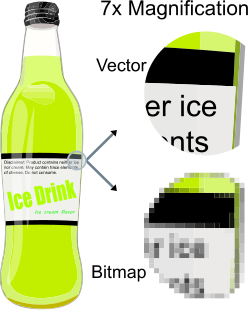
Vector graphics, as a form of computer graphics, is the set of mechanisms for creating visual images directly from geometric shapes defined on a Cartesian plane, such as points, lines, curves, and polygons. These mechanisms may include vector display and printing hardware, vector data models and file formats, and software based on these data models. Vector graphics are an alternative to raster graphics, each having advantages and disadvantages in general and in specific situations.

Star Raiders is a first-person space combat simulator for the Atari 8-bit family of computers. It was written by Doug Neubauer, an Atari employee, and released as a cartridge by Atari in 1979. The game is considered the platform's killer app. It was later ported to the Atari 2600, Atari 5200, and Atari ST.

Inkscape is a free and open-source vector graphics editor used to create vector images, primarily in Scalable Vector Graphics (SVG) format. Other formats can be imported and exported.
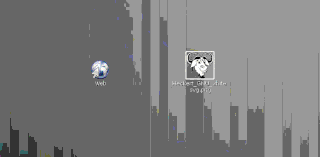
In computer graphical user interfaces, drag and drop is a pointing device gesture in which the user selects a virtual object by "grabbing" it and dragging it to a different location or onto another virtual object. In general, it can be used to invoke many kinds of actions, or create various types of associations between two abstract objects.
2.5D perspective refers to one of two things:
Formatting Objects Processor is a Java application that converts XSL Formatting Objects (XSL-FO) files to PDF or other printable formats. FOP was originally developed by James Tauber who donated it to the Apache Software Foundation in 1999. It is part of the Apache XML Graphics project.

Real-time computer graphics or real-time rendering is the sub-field of computer graphics focused on producing and analyzing images in real time. The term can refer to anything from rendering an application's graphical user interface (GUI) to real-time image analysis, but is most often used in reference to interactive 3D computer graphics, typically using a graphics processing unit (GPU). One example of this concept is a video game that rapidly renders changing 3D environments to produce an illusion of motion.
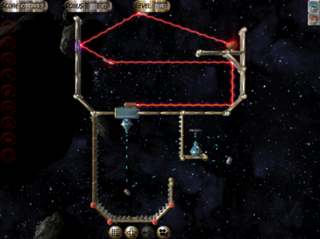
Enigmo and Enigmo 2 are respectively 2.5D and 3D arcade-style computer games for Windows, Mac OS 9, Mac OS X, iOS and PlayStation Minis developed by Pangea Software. They both involve moving certain substances into their proper containers. The music in both games was recorded by Michael Beckett.

Tau Ceti is a video game published in 1985 by CRL for the ZX Spectrum and converted to the Amstrad CPC, Amstrad PCW, Atari ST, Commodore 64, and MS-DOS. It was designed and programmed by Pete Cooke. The world, set on Tau Ceti III orbiting Tau Ceti, is displayed using 3D graphics with shadow effects. The planet has a day and night cycle.
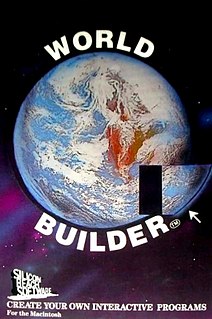
World Builder is a game creation system for point-and-click adventure games. It was released in 1986 by Silicon Beach Software and had already been used for creating Enchanted Scepters in 1984. In 1994, World Builder along with Course Builder, SuperCard, and HyperDA was cited as the reason Appleton was "something of a legend". On August 7, 1995, developer William C. Appleton released World Builder as freeware.

Twin Kingdom Valley is a text adventure game with animated pictures for the BBC Micro, Acorn Electron, Commodore 64, Commodore 16, and ZX Spectrum. It was released in 1983 by Bug-Byte.

Stryker's Run is a video game designed by Chris Roberts and Philip Meller for the BBC Micro and BBC Master which was published by Superior Software in 1986. It was also later converted to the Acorn Electron. It is a 2D side-scrolling action game. It was well received, particularly for its graphics.
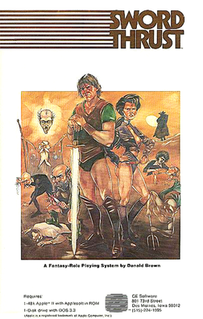
SwordThrust is an interactive text adventure game for the Apple II, created by Donald Brown and published by CE Software in 1981. It consists of seven separate adventures and is the commercial successor to Brown's Eamon (1980).

Obsidian is an action-adventure computer game for the Amstrad CPC personal computer published by Artic Computing in 1986. The game is set on the titular space station located within the centre of an asteroid, which is out of control and drifting towards a black hole. The player must guide an astronaut with a jet pack around the station and re-activate its engine shields to prevent the Obsidian's destruction. This involves collecting items and using them to solve puzzles, while avoiding the Obsidian's reactivated security systems.
A variety of computer graphic techniques have been used to display video game content throughout the history of video games. The predominance of individual techniques have evolved over time, primarily due to hardware advances and restrictions such as the processing power of central or graphics processing units.
An adventure game is a video game in which the player assumes the role of a protagonist in an interactive story driven by exploration and/or puzzle-solving. The genre's focus on story allows it to draw heavily from other narrative-based media, literature and film, encompassing a wide variety of literary genres. Many adventure games are designed for a single player, since this emphasis on story and character makes multiplayer design difficult. Colossal Cave Adventure is identified as the first such adventure game, first released in 1976, while other notable adventure game series include Zork, King's Quest, The Secret of Monkey Island, and Myst.

The Quest is a graphic fantasy text adventure released in 1983 by Penguin Software. It was designed by Dallas Snell for the Apple II and was later ported to the Atari 8-bit family, Commodore 64, MS-DOS, and Macintosh.
Tcl is a high-level, general-purpose, interpreted, dynamic programming language. It was designed with the goal of being very simple but powerful. Tcl casts everything into the mold of a command, even programming constructs like variable assignment and procedure definition. Tcl supports multiple programming paradigms, including object-oriented, imperative and functional programming or procedural styles.













